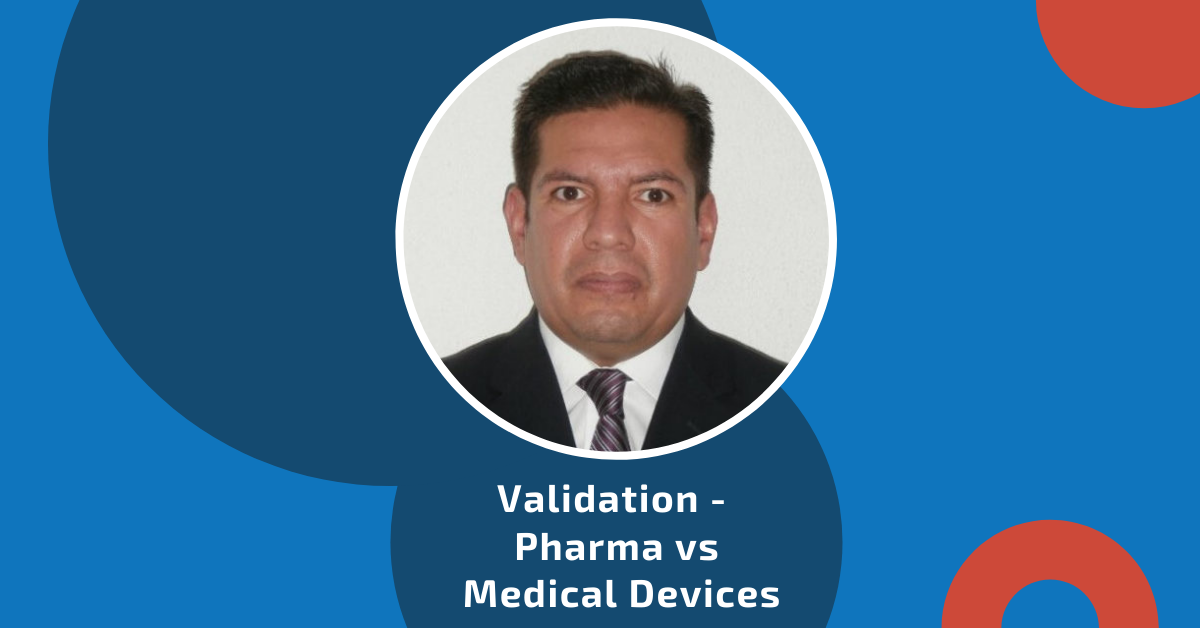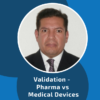
In this episode, Yan Kugel talked to José Sergio Ávila, a validation, and sterilization specialist, about validation activities in the pharmaceutical and medical devices industries.
The covered topics:
- EtO sterilization
- Importance of purified water systems and validation challenges
- Validation of medical devices and the differences to pharmaceutical validation
- How to stay current with the new regulation in the quickly developing field of validation
- Biggest mistakes people do when they perform validations (Audio only, 26:44)
- Tips for becoming experts in the field
Click here to see some of the questions that Yan asked Sergio.
Table of Contents
EtO – Ethylene Oxide Sterilization
EtO is a mutagenic and carcinogenic gas. Manufacturers usually used for sterilization of materials that cannot withstand high temperatures. The gas destroys microorganisms by targeting their cellulars proteins and DNA.
The EtO Sterilization cycle has three stages:
- Preconditioning
- Sterilization
- Aeration
Preconditioning
During this phase, operators prepare the sterilization chamber’s environment for the required conditions. It includes parameters such as temperature, pressure, and humidity. Because EtO works only in a humid climate, the chamber is filled with steam. Then, the chamber is hit to the required temperature, which is somewhere between 22-55°C.
Sterilization
During this face, EtO enters the chamber. Higher gas quantity gas means quicker sterilization. However, it is crucial to keep the gas quantity at a minimum minium, as plastic materials tend to absorb the vapor, according to their properties. Therefore, it is essential to achieving the right balance.
Aeration
This phase is significant, as it removes that gas from the chamber and ensures that the sterilized materials release the absorbed gas. This phase is long and usually lasts 48 hours.
The advantages of the method:
- Doesn’t require high temperatures
- Very efficient against the most robust microorganisms
- High volumes of materials sterilized in one go
- It Doesn’t have a corrosive effect on metal nor plastic.
The disadvantages of the method:
- Takes a very long time
- The technique employs a hazardous and explosive poison
- Expensive methods
- Complicated logistic
Before using the methods, each chamber must be qualified and validated.
When validating the sterilization process, it is essential to take into account the density of the product and the packaging. Those parameters have a significant influence on the way the EtO gas or the gamma radiation interacts with the sterilized product.
Source: https://tuttnauer.com/blog/eto-low-temperature-sterilization
Purified Water Systems
According to Sergio, one of the most critical processes in parenteral is the water for injection. It has a significant impact on the purity of the product and may pose a considerable risk for patients. Manufacturers must validate the systems according to the applicable pharmacopeia.
The most critical parameters in pure water systems are:
- Conductivity
- pH
- Total Organic Carbon
- Microbiology
- Endotoxin
The validation of water systems has 3 phases. The first two phases last at least two weeks. The third phase lasts one year. After completing the first phase successfully, the manufacturer is allowed to use the water for production but must monitor closely.
The biggest mistake that people do during the validation of purified water systems is contaminating it during sampling. So always be careful when you open the sampling valves! Otherwise, you have to start all over again!
Essential things to keep in mind with water for injection systems:
- The construction has to be of stainless steel
- The water must be in a constant flow. Otherwise, it gives chances from microorganisms to settle.
- The sanitization of the water system is required and keeping the temperature at 50°C for preventing microorganisms from settling.
Medical Device Validation
When you validate medical devices, you have other factors to consider than in the pharmaceutical validation. Manufacturers of medical devices use a lot of plastic, and there is a lot of welding, molding, and injection involved. Also, there is the crucial assembly step. All the equipment has to be qualified, and the steps validated. The main factors in medical device manufacturing are the operators who perform the assembly. These employees train in assembly and welding operations and clean room etiquette.
Also, to ensure the safety of the product, extensive statistical analysis needs to be performed. For example, manufacturers need to make sure that the battery in a heart pacer won’t fail. To ensure that, they use methods such as Six Siga, Five S, and sampling plans. The more critical the device, the higher the confidence level it requires (AQL = Acceptance Quality Limit).
Medical Device VS Pharma Validation
Sergio believes that critical pharmaceutical systems are more challenging to validate than medical device processes. The reason for that is that medical devices have a sterilization step in the end, which reduces risks to patients.
How To Stay Current With New Regulations
Sergio suggests spending at least one hour per week reading industry magazines articles.
Here are some of Sergio’s recommendations:
- Pharmaceutical Technology
- Clean Room Technology
- Medical Device Online
- The Scottish Society of Clean Rooms
- Microbiology Forum
- Jim Agalloco
Tips To Become Experts In Validation
- Know a lot about GMP
- Always keep in mind the patient that uses the product
- Know all the parameters that affect the process, like:
- Temperature
- Pressure
- People
- Keep up to date with changing regulations
Some of the questions I ask:
- What are the most critical parameters for validation in parenteral production? (5:17)
- What are the biggest mistakes that people do during water system validation? (7:17)
- How long does it take to train assembly and welding operators in the medical device field? (14:09)
- What qualification assembly and welding operators in the medical device field need to have? (14:58)
- What is more complicated to validate? Pharmaceutical processes or medical devices? (16:09)
- What is most challenging to validate? (17:28)
- How do you stay current with regulations? (25:16)
- What are the biggest mistakes that people do when they perform validations? (26:44)
- What are your tips for people who want to become experts in the validation field? (29:37)




